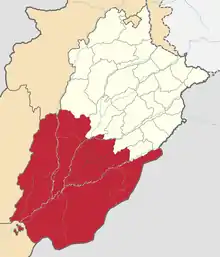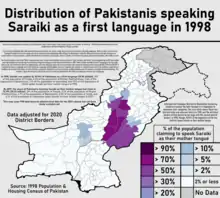Saraikistan
Saraikistan (Saraiki: سرائیکستان) is a proposed new province of Pakistan, comprising the areas with a majority of Saraiki speakers in the southern and western part of Punjab province. The proposed Saraikistan forms about 52 per cent of the total area and 32 per cent of the population of the Punjab province.[1] Saraikistan has a population of 34,743,590 as of 2017.



The proposed territorial extent generally includes 24 districts of Punjab (Multan, Jhang, Okara, Lodhran, Khushab, Bhakkar, Faisalabad, Khanewal, Vehari, Bahawalpur, Toba Tek Singh, Bahawalnagar, Rahim Yar Khan, Dera Ghazi Khan, Layyah, Muzaffargarh, Rajanpur, Pakpattan, Sargodha , Chiniot and Mianwali) and 2 districts of Khyber Pakhtunkhwa (Dera Ismail Khan and Tank).[2][3]
Events
In 2012, Punjab Provincial Assembly and the National Assembly passed resolutions for the creation of new province in Punjab. These resolutions were supported by the Pakistan Peoples Party (PPP) and Pakistan Muslim League (N) (PMLN) and was passed.[4]
In 2013 election the PPP tried to mobilize the Seraiki voters over the Saraikistan province creation. But they got only one National Assembly seat from the Seraikistan region.[5]
In the 2018 the Pakistan Tehreek-e-Insaf (PTI) promised to create a new province in South Punjab within the first 100 days of taking office, if they win.[6]PTI won the election and won 30 out of 50 seats of the National Assembly seats in South Punjab.[7] On August 15, 2018 the PTI MPA of Punjab Assembly, Mohsin Leghari tables a resolution for the creation of a new province in South Punjab.[8]
Establishment of Separate Administrative Secretariat
In 2020, a separate secretariat was established for southern areas of Punjab (Saraikistan). The secretariat is made up of Dera Ghazi Khan Division, Multan Division and Bahawalpur Division. It became officially operational on 15 October 2020.[9] Initially the departments of Services and General administration (S & GAD), Home department, Health, Law, Education, Agriculture, Planning and Development, Live stock and dairy development, Local government and community development, Housing, urban development and Public health engineering, Irrigation, Forest, Communication and works, Revenue[10] and Police are included in the separate Administrative Secretariat of Saraikistan region with following officers:
- Zahid Akhtar Zaman, Additional Chief Secretary (working as Chief Secretary)[11]
- Captain (Retd) Zafar Iqbal, Additional Inspector General of Police[12]
- Momin Agha, Secretary Home department
- Nosheen Malik, Secretary S & GAD
- Dr. Ahtasham Anwar, Secretary Education
- Muhammad Ajmal Bhatti, Secretary Health
- Rana Ubaidullah Anwar, Secretary Finance
- Shoaib Iqbal Syed, Secretary Planning and Development
- Rana Khurram Shehzad Umar, Secretary Local government and community development
- Liaqat Ali Chatha, Secretary Housing, Urban development and Public health engineering
- Saqib Ali Ateel, Secretary Agriculture
- Aftab Ahmad Pirzada, Secretary Live stock and dairy development
- Nadeem Ahmad Gajana, Secretary Law[13]
Geography
The Seraikistan Qaumi Council demanded the creation of Seraikistan province by merging 24 districts in South Punjab and 2 districts in Khyber Pakhtunkhwa (Dera Ismail Khan and Tank districts, there 70 percent of the people speaks Seraiki).
The Main Political parties PTI, PPP and PML(N) have difference on the geography of Seraikistan. The PPP supports the formation of the South province by merging 11 districts of Punjab and 2 districts of Khyber Pakhtunkhwa. The PTI supports the formation of the South Punjab province by merging 11 districts South Punjab only. The PML(N) supports the formation of two provinces in South Punjab -the Bahawalpur Province and another South Punjab province containing Dera Ghazi Khan and Multan divisions.[14]
See also
- Bahawalpur South Punjab, another proposed province in this region
- Qabailistan, a proposed province in western Khyber Pakhtunkhwa, Pakistan
- Saraiki culture
References
- "South Punjab: larger in size, less in population". Retrieved 13 April 2020.
- "A province for Seraikis". Retrieved 16 April 2020.
- Rahman 1995, p. 4.
- "What lies behind demands for a separate province in south Punjab". Retrieved 16 April 2020.
- "What lies behind demands for a separate province in south Punjab". Retrieved 16 April 2020.
- "A province for Seraikis". Retrieved 16 April 2020.
- "A province in the making". Retrieved 16 April 2020.
- "What lies behind demands for a separate province in south Punjab". Retrieved 16 April 2020.
- https://www.dawn.com/news/1577999
- https://www.dawn.com/news/amp/1577291
- https://www.radio.gov.pk/01-07-2020/aig-acs-appointed-for-south-punjab-secretariat-on-merit-cm-buzdar
- https://www.24newshd.tv/26-Sep-2020/capt-retd-zafar-iqbal-appointed-additional-igp-south-punjab?_gl=1*yilk5m*_ga*S1ZNb0FFa2ZNU0ItTm4wbWxxTVVCZW9ncEVlNUw1SGZydVFZQlN3TG9FQVRoU0RicmMxN3JONVhCWmdzWUFLYg..
- https://www.facebook.com/groups/seraikitehreek/permalink/3318592354904141/
- "A province for Seraikis". Retrieved 16 April 2020.
Bibliography
- Rahman, Tariq (1995). "The Siraiki Movement in Pakistan". Language Problems & Language Planning. 19 (1): 1–25. doi:10.1075/lplp.19.1.01rah.CS1 maint: ref=harv (link)